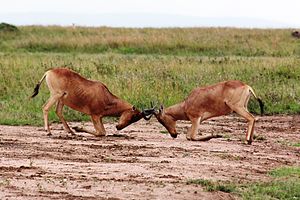
Back المنافسة داخل النوع Arabic Intraspezifische Konkurrenz German Intraspecia konkurenco Esperanto Competencia intraespecífica Spanish رقابت درونگونهای Persian Compétition intraspécifique French Competizione intraspecifica Italian Competição intraespecífica Portuguese Intraspecific competition SIMPLE Tür içi rekabet Turkish

Intraspecific competition is an interaction in population ecology, whereby members of the same species compete for limited resources. This leads to a reduction in fitness for both individuals, but the more fit individual survives and is able to reproduce.[1] By contrast, interspecific competition occurs when members of different species compete for a shared resource. Members of the same species have rather similar requirements for resources, whereas different species have a smaller contested resource overlap, resulting in intraspecific competition generally being a stronger force than interspecific competition.[2]
Individuals can compete for food, water, space, light, mates, or any other resource which is required for survival or reproduction. The resource must be limited for competition to occur; if every member of the species can obtain a sufficient amount of every resource then individuals do not compete and the population grows exponentially.[1] Prolonged exponential growth is rare in nature because resources are finite and so not every individual in a population can survive, leading to intraspecific competition for the scarce resources.
When resources are limited, an increase in population size reduces the quantity of resources available for each individual, reducing the per capita fitness in the population. As a result, the growth rate of a population slows as intraspecific competition becomes more intense, making it a negatively density dependent process. The falling population growth rate as population increases can be modelled effectively with the logistic growth model.[3] The rate of change of population density eventually falls to zero, the point ecologists have termed the carrying capacity (K). However, a population can only grow to a very limited number within an environment.[3] The carrying capacity, defined by the variable k, of an environment is the maximum number of individuals or species an environment can sustain and support over a longer period of time.[3] The resources within an environment are limited, and are not endless.[3] An environment can only support a certain number of individuals before its resources completely diminish.[3] Numbers larger than this will suffer a negative population growth until eventually reaching the carrying capacity, whereas populations smaller than the carrying capacity will grow until they reach it.[3]
Intraspecific competition does not just involve direct interactions between members of the same species (such as male deer locking horns when competing for mates) but can also include indirect interactions where an individual depletes a shared resource (such as a grizzly bear catching a salmon that can then no longer be eaten by bears at different points along a river).
The way in which resources are partitioned by organisms also varies and can be split into scramble and contest competition. Scramble competition involves a relatively even distribution of resources among a population as all individuals exploit a common resource pool. In contrast, contest competition is the uneven distribution of resources and occurs when hierarchies in a population influence the amount of resource each individual receives. Organisms in the most prized territories or at the top of the hierarchies obtain a sufficient quantity of the resources, whereas individuals without a territory don’t obtain any of the resource.[1]
- ^ a b c Townsend (2008). Essentials of Ecology. Wiley. pp. 103–105. ISBN 978-1-4051-5658-5.
- ^ Connell, Joseph (November 1983). "On the prevalence and relative importance of interspecific competition: evidence from field experiments" (PDF). American Naturalist. 122 (5): 661–696. doi:10.1086/284165. S2CID 84642049. Archived from the original (PDF) on 2014-10-26.
- ^ a b c d e f Gause, Georgy (October 1932). "Experimental studies on the struggle for existence". Journal of Experimental Biology. 9 (4): 389–402. doi:10.1242/jeb.9.4.389.